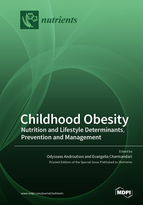Childhood Obesity: Nutrition and Lifestyle Determinants, Prevention and Management
A special issue of Nutrients (ISSN 2072-6643). This special issue belongs to the section "Nutritional Epidemiology".
Deadline for manuscript submissions: closed (31 July 2021) | Viewed by 102870
Special Issue Editors
Interests: clinical nutrition; pediatric nutrition; obesity; obesity-related diseases
Special Issues, Collections and Topics in MDPI journals
2. Division of Endocrinology and Metabolism, Center of Clinical, Experimental Surgery and Translational Research, Biomedical Research Foundation of the Academy of Athens, 11527 Athens, Greece
Interests: childhood obesity; adolescent endocrinology; growth disorders; disorders of sex development; gender dysphoria; anorexia nervosa; stress-related disorders; molecular mechanisms of glucocorticoid action
Special Issues, Collections and Topics in MDPI journals
Special Issue Information
Dear Colleagues,
The prevalence of overweight and obesity has significantly increased over the past few decades and is linked to metabolic diseases across the lifespan. Its etiology has been attributed to a large number of sociodemographic, behavioral (e.g. unhealthy nutrition, low levels of physical activity), perinatal, and clinical risk factors, which are active already from childhood and adolescence. Still, their exact role, interplay, and mechanisms implicated in this process remain unclear. The trends of childhood obesity call for actions regarding the prevention and management of this disease early in life.
The Special Issue “Childhood Obesity: Nutrition and Lifestyle Determinants, Prevention and Management” aims to host original articles, systematic reviews or meta- analyses that will advance the current knowledge on the role of health behaviors, especially of nutrition, on the development of overweight or obesity in childhood and adolescence, provide valuable information about the nutritional habits of overweight/obese children and adolescents, and describe novel approaches via lifestyle modification for the prevention or management of obesity in youth.
Dr. Odysseas Androutsos
Prof. Dr. Evangelia Charmandari
Guest Editors
Manuscript Submission Information
Manuscripts should be submitted online at www.mdpi.com by registering and logging in to this website. Once you are registered, click here to go to the submission form. Manuscripts can be submitted until the deadline. All submissions that pass pre-check are peer-reviewed. Accepted papers will be published continuously in the journal (as soon as accepted) and will be listed together on the special issue website. Research articles, review articles as well as short communications are invited. For planned papers, a title and short abstract (about 100 words) can be sent to the Editorial Office for announcement on this website.
Submitted manuscripts should not have been published previously, nor be under consideration for publication elsewhere (except conference proceedings papers). All manuscripts are thoroughly refereed through a single-blind peer-review process. A guide for authors and other relevant information for submission of manuscripts is available on the Instructions for Authors page. Nutrients is an international peer-reviewed open access semimonthly journal published by MDPI.
Please visit the Instructions for Authors page before submitting a manuscript. The Article Processing Charge (APC) for publication in this open access journal is 2900 CHF (Swiss Francs). Submitted papers should be well formatted and use good English. Authors may use MDPI's English editing service prior to publication or during author revisions.
Keywords
- Childhood obesity
- Nutrition
- Diet
- Determinants
- Risk factors
- Energy-balance-related behaviors
- Prevention
- Treatment
- Management








